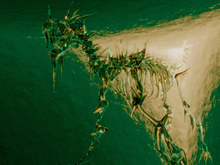The Hounds of Tindalos are fictional creatures created by Frank Belknap Long and later incorporated into the Cthulhu Mythos when it was codified by August Derleth.[1] They first appeared in Long's short story "The Hounds of Tindalos", first published in the March 1929 issue of Weird Tales.[2] Lovecraft mentions the creatures in his short story "The Whisperer in Darkness" (1931).
| Hounds of Tindalos | |
|---|---|
 Artist impression of a hound of Tindalos | |
| First appearance | "The Hounds of Tindalos" |
| Created by | Frank Belknap Long |
| In-universe information | |
| Species | Pseudocanis tindalosi |
| Type | Extraterrestrial life form |
Description
editIn Frank Belknap Long's original story, which deals with the main character experimenting in time travel with the help of psychedelic drugs and esoteric artifacts, the Hounds are said to inhabit the angles of time, while other beings (such as humankind and all common life) descend from curves.
Though the Hounds are sometimes pictured as canine, probably because of the evocative name, their appearance is unknown, since neither Long nor Lovecraft describe them, arguing they are too foul to ever be described.[3] Long's story states that their name "veils their foulness". It is said that they have long, hollow tongues or proboscises to drain victims' body-fluids, and that they excrete a strange blue pus or ichor. They can materialize through any corner if it is fairly sharp—120° or less. When a Hound is about to manifest, it materializes first as smoke pouring from the corner, and finally the head emerges followed by the body. It is said that once a human becomes known to one of these creatures, a Hound of Tindalos will pursue the victim through anything to reach its quarry. A person risks attracting their attention by traveling through time.
In other media
editThe Wolves, perennial antagonists of the four-season horror comic series Witch Creek Road (2017–2021) and its spin-off Witch Creek High (2023; on hiatus) by Garth Matthams and Kenan Halilović, were based on the Hounds of Tindalos.[4][5][6][7]
References
edit- ^ Joshi, S.T.; Schultz, David E. (2004). An H.P. Lovecraft Encyclopedia. Hippocampus Press. p. 151. ISBN 978-0974878911.
- ^ Emrys, Ruthanna (21 July 2015). "Avoiding Angles is Harder Than It Sounds: "The Hounds of Tindalos"". Tor. Retrieved 27 February 2018.
- ^ Ramos, Octavio (21 October 2014). "Lovecraftian Beasties: The Hounds of Tindalos". AXS. Archived from the original on 16 June 2018. Retrieved 27 February 2018.
- ^ Freeman, John (March 19, 2021). "Witch Creek Road Spotlight: Revenge, Love & Flesh-Eating Demons". John Freeman Writer. Retrieved January 10, 2025.
- ^ Matthams, Garth; Halilović, Kenan (June 19, 2021). "Witch Creek Road S4 E1 Commentary". Witch Creek Road. Retrieved June 19, 2021.
- ^ Keith, Jed W. (May 28, 2024). "Interview: Garth Matthams & Kenan Halilović on a "Love Letter to Horror" in Witch Creek Road". Freaksugar. Retrieved January 10, 2025.
For Witch Creek Road, HP Lovecraft was definitely an influence – though the biggest influence for Season 1 was the short story, "The Hounds of Tindalos" by Frank Belknap Long.
- ^ Matthams, Garth; Halilović, Kenan (December 17, 2021). "Witch Creek Road S4 Q&A Cont". Witch Creek Road. Retrieved December 17, 2021.
Is this an expansion of Lovecraft lore? Or are the Lovecraft elements just there for flavor? The Lovecraft elements have been present since the beginning – it was just a lot more obvious in the final season. The Wolves, for example, were inspired by, and related to, the Hounds of Tindalos. (Get it? Wolves? Hounds?) The Wolves are counterparts to the Hounds. The Hounds hunt (and kill) people who attempt to manipulate time (such as time travelers). The Wolves, on the other hand, deal with abnormalities - that is, something that shouldn't be present within the Curves. Unfortunately, when Wolves are summoned by a person, they have no particular direction, and so they run amok - which is, essentially, the only time we've seen them. Lovecraftian stories also deal pretty heavily with the idea that people aren't equipped to fight monsters, and that the best one can generally hope for is to survive and not go mad - and this has been a pretty standard theme throughout the seasons of Witch Creek Road. So I'd say that, while some elements were added for flavor (such as the mention of Dunwich in Season 1, the fact that the high school was named Halsey High, etc), the story and ideas were definitely an expansion of Lovecraftian lore.
Sources
edit- Long, Frank Belknap. "The Hounds of Tindalos" (1929). In Tales of the Cthulhu Mythos (1st ed.), Random House, 1998. ISBN 0-345-42204-X.